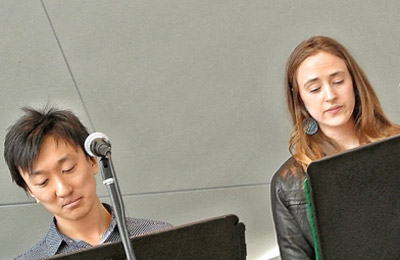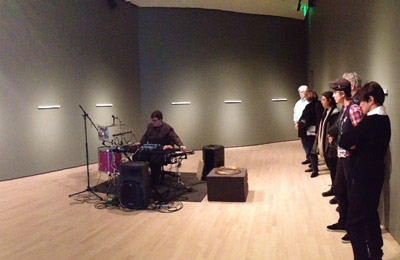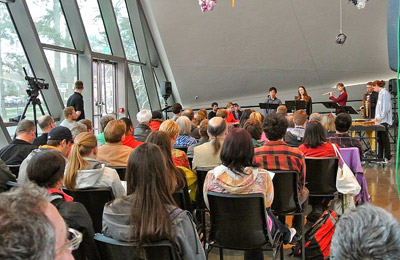News
The Shape of Collaboration
 College of Music and Broad Art Museum bring sound to exhibits.
College of Music and Broad Art Museum bring sound to exhibits.



Creative collaborations between two artistic forces at Michigan State University are forming a space of sound and vision for the campus and community.
Throughout the past two years, faculty and students at the College of Music have worked with leadership at the new Eli and Edythe Broad Art Museum to produce events that merge art and sound.
“The Broad itself is a very productive and catalytic structure for creative thought,” says Mark Sullivan, associate professor of composition at the College of Music. “From the point of view of how you experience paintings and music within it, it’s a gold mine.”
Sullivan joins other faculty and students leading the way to forge ongoing programming that blends original or interpreted musical compositions with exhibits at the Broad.
“When you collaborate, you get something very beautiful and unique to our location,” says Tammy Fortin, manager of public programs at the Broad. “It’s all about connectivity between the museum and the College of Music.”
Fortin says the Broad always looks for ways to bring exhibits into context. Combining music with openings or hosting performances that complement exhibits can engage audiences in different ways and build on the theme and understanding of musical and visual works.
“We try not to put up boundaries between different forms of art,” says Fortin. “The more interdisciplinary things are, the more interesting it can be.”
Zac Brunell was among recent student musicians who created “soundtracks” that meshed with two recent exhibits at the Broad.
A percussion performance major, Brunell’s first collaboration involved a performance and presentation on the architect/composer Iannis Xenakis as part of an architecture exhibit in December 2013. His second initiative involved creating an electronic sound installation to accompany the spring 2014 exhibit “Sabachthani” by artist Margaret Evangeline.
“Her work elevated my music, and my music helped translate her message to the public,” says Brunell. “Whatever both of us were trying to say was doubled in strength. It makes that much more impact on whoever comes to see it.”
Graduate student Philip Rice also melded his discipline with a conceptual exhibit at the Broad. Rice, who is pursing his doctorate in music composition, worked with fellow graduate student Patrick Bonczyk to explore the gap between math and science. Their experimental work “Polygon” culminated in a performance with four other MSU student musicians as part of the Broad’s “Postscript” exhibit in April.
“The Broad was perfect because of the shapes and angles of the space,” says Rice. “And the audience consisted of art and music lovers, and enthusiasts of math and linguistics. It was a great way to bring people together from different spheres of influence who don’t normally get to interact.”
Fortin noted that the recent collaborative events attracted audiences of 100 or more—some with standing room only. She added that Broad’s unique spaces make it a laboratory for artists and musicians that can foster new, inspired, or experimental works.
“It’s a way to break out of the standard concert hall setting and to play around with the limitations they may not have thought of before,” says Fortin. “We have to embrace chaos when we have a concert here with all the stainless steel, glass and concrete. But when it’s all said and done, the concerts and collaborations we have here are beautiful.”
Photos courtesy: Mark Sullivan; Sabachthani exhibit, Candice Wilmore; Polygon exhibit.


